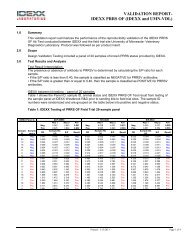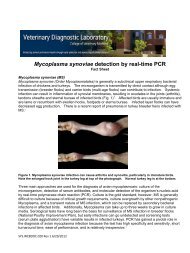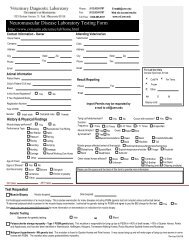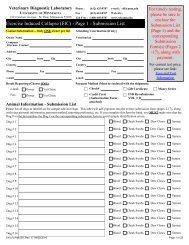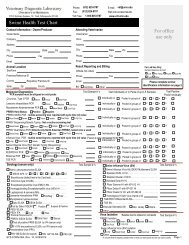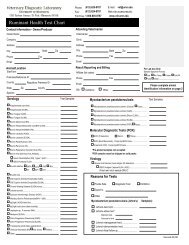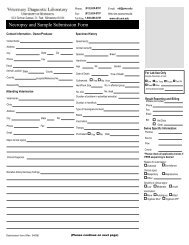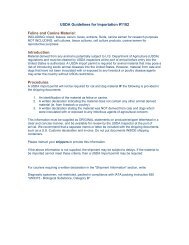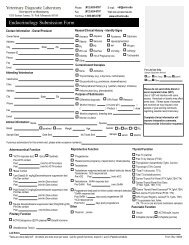Clostridial abomasitis and abomasal bloating in calves - Veterinary ...
Clostridial abomasitis and abomasal bloating in calves - Veterinary ...
Clostridial abomasitis and abomasal bloating in calves - Veterinary ...
Create successful ePaper yourself
Turn your PDF publications into a flip-book with our unique Google optimized e-Paper software.
• Clostridium perfr<strong>in</strong>gens type A is found<strong>in</strong> the <strong>in</strong>test<strong>in</strong>es of nearly all warm‐blooded healthy <strong>and</strong> sick animals.• Clostridium perfr<strong>in</strong>ges type A is found<strong>in</strong> soil, dust, contam<strong>in</strong>ated feeds, etc.• Experimental reproduction of thedisease is difficult <strong>and</strong> <strong>in</strong>consistent.i t• Feed<strong>in</strong>g high levels of Clostridium perfr<strong>in</strong>ges tohealthy <strong>calves</strong> doesn’t cause disease.• Antibiotics• Oral Penicill<strong>in</strong>• Relieve gas• Oral tube won’t get to theabomasum• Vacc<strong>in</strong>ate?• Clean, clean, clean?• Blame ‘management’?
• The goal of <strong>Clostridial</strong> vacc<strong>in</strong>ation is tohave the animal to produce <strong>and</strong> immuneresponse <strong>and</strong> make antibodies thatneutralize (b<strong>in</strong>d) the bacterial tox<strong>in</strong>s.• Generally speak<strong>in</strong>g, this works well.• <strong>Clostridial</strong> vacc<strong>in</strong>es WILL NOT• Prevent livestock from consum<strong>in</strong>g Colostrial spores• Prevent the creation of an anaerobic (<strong>Clostridial</strong>)environment• Prevent Clostridium from grow<strong>in</strong>g <strong>in</strong> the anaerobicenvironment• Prevent <strong>Clostridial</strong> l gas production <strong>and</strong> <strong>bloat<strong>in</strong>g</strong>• Vacc<strong>in</strong>es are good at target<strong>in</strong>g the tox<strong>in</strong>.Type Major Tox<strong>in</strong> Disease of.... NotesType A Alpha Stomach <strong>and</strong><strong>in</strong>test<strong>in</strong>es, “foodpoison”Type BAlpha, Beta &EpsilonIntest<strong>in</strong>es of lambs,<strong>calves</strong> <strong>and</strong> foalsThe bacteria is widespread. Toxiceffects of alpha tox<strong>in</strong> are<strong>in</strong>consistentThe beta tox<strong>in</strong> is consistentlylethalType C Alpha & Beta Intest<strong>in</strong>es of pigs,birds, lambs, <strong>calves</strong>,Well controlled <strong>in</strong> sheep with “C+ D vacc<strong>in</strong>es.” Occasionallygoats <strong>and</strong> foals diagnosed <strong>in</strong> pigs. Rare <strong>in</strong> cattleType D Alpha &EpsilonIntest<strong>in</strong>es of lambs<strong>and</strong> goats“Pulpy kidney” <strong>in</strong> lambs, wellcontrolled by vacc<strong>in</strong>ation. Theepsilon tox<strong>in</strong> is lethal
• Alpha tox<strong>in</strong>• When the alpha tox<strong>in</strong> is <strong>in</strong>jection <strong>in</strong> to mice, it’s not aways lethal• Mild when compared to beta <strong>and</strong> epsilon tox<strong>in</strong>• Beta <strong>and</strong> Epsilon tox<strong>in</strong>• Much more lethal than the alpha tox<strong>in</strong>• Well controlled by vacc<strong>in</strong>ation (C <strong>and</strong> D) vacc<strong>in</strong>es <strong>in</strong> sheep• Rarely diagnosed <strong>in</strong> cattle• Upon exam<strong>in</strong>ation, <strong>calves</strong> ultimately die of bloat,ulceration, septicemia <strong>and</strong> <strong>and</strong>/or <strong>abomasal</strong>perforation associated with the retention of“bacterial soup” <strong>and</strong> not alpha tox<strong>in</strong> damage.One, or more, are potential causes...1. Contam<strong>in</strong>ated colostrum <strong>and</strong>/or milk (Bacterial soup)2. Improperly mixed (hyperconcentrated) milk replacer3. Free‐choice water availability problems.4. Improperly mixed (hyperconcentrated) electrolytes5. Excessive oral supplements, probiotics, & antibiotics6. Heat‐damaged milk from pasteurization7. Poorly digestible, plant‐based milk replacers8. Erratic feed<strong>in</strong>g schedules (9 AM <strong>and</strong> 4 PM)
• Newborn <strong>calves</strong> make little stomach acids to kill bacteria• Colostrum <strong>and</strong> milk are an ideal media for bacteria.• If <strong>calves</strong> are dy<strong>in</strong>g <strong>in</strong> the first 5 day, I usually suspect failureof passive transfer <strong>and</strong>/or consumption of contam<strong>in</strong>atedcolostrum or milk (“bacterial soup”)• CALVES CAN NOT VOMIT, if they could, they would.•Calves need water to digest milk solids• Water = oxygen = digestion = no Clostridium• Water = no oxygen = <strong>Clostridial</strong> digestion• In the absence of water (<strong>and</strong> oxygen)• Clostridium sp. digest the milk, then theabomasum = <strong>in</strong>fection = bloat/perforation = dead.
• 20:20 Replacer• 26:18 Accelerated• Bulk tank milk• 3.0 % Prote<strong>in</strong> • 2.1 % Prote<strong>in</strong> • 3.6 % Prote<strong>in</strong>• 3.8 % Fat• 2.1 % Fat• 2.3 % Fat• 5.75 % Other solids • 6.3% % Other solids • 7.0 % Other solids• 12.55 % Solids • 10.5 % Solids • 13.0 % Solids• Already mixed, the• 8 oz. of powder <strong>in</strong>• 14.44 oz. of powder <strong>in</strong>ratios rema<strong>in</strong> the same2 quarts of water 3 quarts of water• Feed more, properly mixed milk replacer• Replace your 2 quart nipple bottles with 3quart bottles• Add digestible fat to <strong>in</strong>crease calorieswithout t <strong>in</strong>creas<strong>in</strong>g the osmolarity• Fat does NOT need extra water (<strong>and</strong> oxygen) for digestion• Fat is 2.5X more energy dense that sugars <strong>and</strong> prote<strong>in</strong>s• Generally speak<strong>in</strong>g, Clostridium sp. do not digest fats
• Offer<strong>in</strong>g free‐choice watermight not resolve the problem.• Water freezes• Small <strong>calves</strong> may not reach thewater <strong>in</strong> the bucket.• 24 <strong>in</strong>ches from the ground to top of bucketto bottome of bucket.• Are <strong>calves</strong> smart? Do they knowthey should dr<strong>in</strong>k water?• Make the decision for them <strong>and</strong>put the water with the replacer.• Electrolytes are “salts”• Sodium, chloride, potassium, etc.• Wherever salts go, water follows• The “saltyness” of a solution ismeasured <strong>and</strong> reported as Osmolarity.• Osmolarity of various fluids.• Milk ~ 300 mOsm/L• Gatorade ~ 300 mOsm/L• Blood serum ~ 300 mOsm/L• Sea water ~ 800 mOsm/L• Sugars <strong>and</strong> Prote<strong>in</strong> alsoact like Salts <strong>and</strong> “pull fluids”• Sugar on strawberries = juice• Fat does not act like a salt<strong>and</strong> does not “pull fluids”
Osmolarity or“saltyness” of theseelectrolytes rangesfrom 245 to 739mOsm/L (If they aremixed with theproper amount ofwater as directed onthe label).Smith, Vet Cl<strong>in</strong> Food Anim 25, 2009• Excessive osmolarity (or salt<strong>in</strong>ess) of oral fluids canquickly dehydrate a young calf• Salty fluids pull water <strong>and</strong> can cause diarrhea.• Dehydration is a loss of water, electrolytes, <strong>and</strong> oxygen• of Water = of oxygen = risk of <strong>Clostridial</strong> growth• Excessive osmolarity can also slow the GI flow <strong>and</strong>“stall” the movement of nutrients <strong>in</strong> the <strong>in</strong>test<strong>in</strong>es.CalfStomach
• Anyth<strong>in</strong>g added to milk <strong>and</strong> milk replacer has thepotential to <strong>in</strong>crease the osmolarity.• Excessive oral, <strong>and</strong> extralabel, antibiotics can• Increase the osmolarity• Disrupt the normal bacterial flora• In some cases, lead to fungal stomach <strong>in</strong>fections.• Example:• Electrolyte (Entrolyte H E) + Antibiotic (Baytril*) =Osmolarity 913*Extra‐label use of Baytril is prohibited• Similar problems have been seen with excessive amounts oforal tetracycl<strong>in</strong>es.• If a calf can’t digest the prote<strong>in</strong>s <strong>and</strong> sugars,Clostridium sp. might• Feed an all‐milk replacer for at least 2 weeks.
• Calf heath problems?• Feed 3 quarts/feed<strong>in</strong>g of whole milk from ahealthy cow.• Add a colostrum cube from a rota/coronavacc<strong>in</strong>ated cows to control viruses• Discont<strong>in</strong>ue all supplements...simple is good• Scared? Try it bull <strong>calves</strong>.• Create sent<strong>in</strong>el <strong>calves</strong>.• Sent<strong>in</strong>el –A calf the you are OK to sacrifice for test<strong>in</strong>g• Do not treat <strong>and</strong> have the vet euthanize, necropsy<strong>and</strong> submit a full set of tissues to the lb lab.• Alternatively, drive the live calf to the D‐lab.
• Clostridium spp. bacteria are commonly isolatedfrom the stomachs of <strong>calves</strong> with <strong>abomasal</strong> bloat.• Clostridium spp. appear to thrive because we’vecreated an enviroment for anaerobic growth• No water = no oxygen = <strong>Clostridial</strong> growth• Calf <strong>bloat<strong>in</strong>g</strong> <strong>and</strong> death is a syndrome with multiplepotential causes, consult the list of 8.• If changes don’t resolve the problem• Consider feed<strong>in</strong>g whole cows milk <strong>and</strong> colostrum cubes• Consider sacrific<strong>in</strong>g sent<strong>in</strong>el <strong>calves</strong> for diagnostic tests1. Songer JG; <strong>Clostridial</strong> enteric diseases of domestic animals. Cl<strong>in</strong>.Microbiol. Rev. 1996 9(2): 2162. Songer JG, Miskim<strong>in</strong>s DW; <strong>Clostridial</strong> <strong>abomasitis</strong> <strong>in</strong> <strong>calves</strong>: Casereport <strong>and</strong> review of the literature. Anaerobe. 2005 11, 290‐2943. Daly R; Clostridium perfr<strong>in</strong>gens <strong>in</strong>fections <strong>in</strong> baby <strong>calves</strong>. SDSUExtension Extra 11022. 20074. Britt J; They were kill<strong>in</strong>g their <strong>calves</strong>. M<strong>in</strong>nesota Dairy HealthConference Proceed<strong>in</strong>gs, 20065. Smith G; Treatment of Calf Diarrhea: Oral Fluid Therapy.Veter<strong>in</strong>ary Cl<strong>in</strong>ics of North America Food Animal 25, 55‐72, 7, 2009



